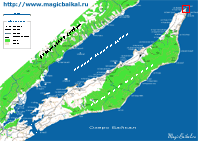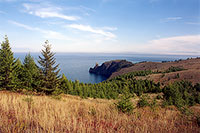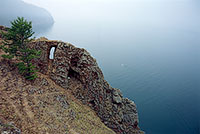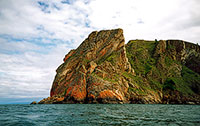Cape Khoboy
In the north of the island, Olkhon's steppe, bordered by tracts of forest near Baikal's shores, takes the traveller to its last headland and opens up ones eyes to an astonishing work of nature on this marvellous island: bent like some fantastic animal basking in the sun, beneath one, lies Cape Khoboy, its ridge unfurled in such a way that it is clear that there is no way forward. Ahead, there is only the blue of Baikal and its far distant eastern shore, so far, that it can be seen only after rain or a strong wind. From Khoboy, Olkhon's cliffs stretched out unseen towards that distant shore, having plunged into Baikal's waters to become the Akademicheskii underwater ridge, and 70 kilometres further on to surface again to form the archipelago of the Ushkanyi islands.
Khoboy got its name from the most prominent part of the cape¬Ý‚Äî a flat stone platform with a form like the fang of an animal (¬´Khoboy¬ª means fang in the Buryat language). Time, Baikal's winds, cruel frosts and burning sunshine have left their indelible mark on Khoboy's fang¬Ý‚Äî in places it is pierced by holes. There is a large opening through the ridge of the cliff itself linking the island with the platform. The opening is big enough for a person to stand up in with ease. Khoboy has yet another face that can be seen in summer from the water or in winter from the ice: the southern end of the ¬´fang¬ª seen from the side resembles a woman's profile and is called Dyeva (the maiden).
The uniqueness and severe beauty of Khoboy was fittingly valued by the ancient islanders,— Khoboy was considered sacred and served as a place where religious rights were acted out. On enormous boulders, jutting out of the waters near the cape, seal set up their haul out. Today, the cape is officially recognised as a natural landscape–monument, but the seal is now a rare visitor. Only sometimes a black head will pop up out of the water at some distance from the land, will look at this inhospitable shore with fearful eyes, and quickly disappear into the safety of the deep.
In winter, Khoboy turns into a fabulous ice castle. Heavy autumn waves breaking on the cape stay on the rocks in ¬´sokui¬ª¬Ý‚Äî ice pillars sprayed into weird forms. Two wave‚Äìhollowed grottos become the halls of this ice palace, as seen from the north of the cape. On the side of Big Baikal, not far from Khoboy, cracks and fields of massive hummocks form each winter.
© Magic Baikal
Related links:




